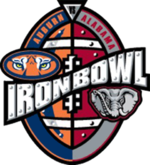 | |
| Sport | College football |
|---|---|
| First meeting | February 22, 1893 Auburn 32, Alabama 22 |
| Latest meeting | November 25, 2023 Alabama 27, Auburn 24 |
| Next meeting | November 30, 2024 |
| Trophy | James E. Foy, V-ODK Sportsmanship Trophy |
| Statistics | |
| Meetings total | 88 |
| All-time series | Alabama leads 50–37–1 (.574)[1] |
| Largest victory | Alabama, 55–0 (1948) |
| Longest win streak | Alabama, 9 (1973–1981) |
| Current win streak | Alabama, 4 (2020–present) |
The Alabama–Auburn football rivalry, better known as the Iron Bowl,[2] is an American college football rivalry game between the University of Alabama Crimson Tide and the Auburn University Tigers, both charter members of the Southeastern Conference (SEC) and both teams are located in the state of Alabama. The series is considered one of the most important football rivalries in American sports.[3][4] The rivalry, which started in 1893, was played for many years at Legion Field in Birmingham, Alabama. In the early 20th Century, Birmingham was the leading industrial city of the South, rivaling Pittsburgh, Pennsylvania, in the production of pig iron, coke, coal and the manufacture of steel. Thus, the term "Iron Bowl" came to represent the rivalry.[5] Auburn Coach Ralph "Shug" Jordan is credited with actually coining it—when asked by reporters in 1964 how he would deal with the disappointment of not taking his team to a bowl game, he responded, "We've got our bowl game. We have it every year. It's the Iron Bowl in Birmingham."[6]
The game was traditionally played on Thanksgiving weekend, but in 1993, the schools agreed to move the game up to the week before Thanksgiving to give themselves a bye for a potential SEC Championship Game berth after the game was introduced in the 1992 season. In 2007 the conference voted to disallow any team from having a bye before the league championship game, returning the game to its traditional Thanksgiving weekend spot.
The rivalry has long been one of the most heated collegiate rivalries in the country. It is all the more heated because the two schools have been among the nation's elite teams for most of the time since the 1950s. Together, they account for 38 SEC titles, 30 by Alabama and 8 by Auburn. Both are among the most successful programs in major college football history; Alabama is second[7] in all-time total wins among Division I FBS schools while Auburn is 13th.[7] The two schools have been fixtures on national television since the late 1970s; the only time since then that the season-ending clash has not been nationally televised was in 1993, when Auburn was barred from live TV due to NCAA sanctions. Alabama leads the series with a record of 50–37–1.
For much of the 20th century, the game was played every year in Birmingham, with Alabama winning 34 games and Auburn 18. Four games were played in Montgomery, Alabama, with each team winning two.[8] In Birmingham's Legion Field, tickets were evenly divided between the two schools. In even years, Alabama was designated as home team and Auburn was the home team in odd-numbered years. Auburn broke with tradition in 1989, opting to move the game to its home stadium for the first time. The Tigers agreed to play one additional game as home team in Birmingham in 1991 before moving its home games permanently to Jordan-Hare Stadium in Auburn beginning in 1993. Alabama continued scheduling its home games in the series in Birmingham through the 1998 season before moving its home games to Bryant-Denny Stadium in Tuscaloosa permanently beginning in 2000.
- ^ Cite error: The named reference
serieswas invoked but never defined (see the help page). - ^ Rollins, Khadrice (November 25, 2017). "Why is Alabama vs. Auburn Called the Iron Bowl?". SI.com. Retrieved October 15, 2024.
- ^ "The ten greatest rivalries". ESPN. January 3, 2007. Retrieved October 12, 2008.
- ^ Rappoport, Ken; Barry Wilner (2007). "The Iron Bowl: Auburn–Alabama". Football Feuds: The Greatest College Football Rivalries. Globe Pequot. p. 77. ISBN 978-1-59921-014-8.
- ^ Armes, Ethel (1907). The Story of Coal and Iron in Alabama. University of Alabama Press. pp. xxv. ISBN 9780817356828.
- ^ Gray, Jeremy (November 26, 2014). "Iron Bowl 1964 was the first nationally televised, possibly the first called Iron Bowl". AL.com. Retrieved October 15, 2024.
- ^ a b "Football Bowl Subdivision Records" (PDF). NCAA.org (2021 ed.). NCAA. p. 103. Retrieved January 5, 2022.[permanent dead link]
- ^ Staff (2016) "The Iron Bowl—wins and losses through the years" Archived November 27, 2016, at the Wayback Machine WSFA website


